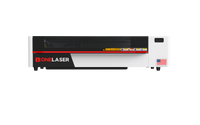A laser engraving business might be the chance you've been looking for if you've ever thought about making money from your creative ideas. Laser engraving is now one of the most exciting and profitable niches for makers, hobbyists, and business owners. It can be used to make everything from personalized gifts to large orders for businesses.
The best part is? You don't need a big factory or a lot of people to get started. A lot of successful small businesses start out with just one laser engraver in a spare room, garage, or even a mobile trailer. If you have the right tools and plan, you can turn a simple side job into a successful business that pays for your way of life.
Key Takeaway
This full guide is based on the work of Colby Sechelski, a Florida-based maker dad who started a business from scratch using laser engraving machines. Colby's story shows that it's not only possible to start a laser cutting business, but it's also possible to keep it going, even in markets with a lot of competition. This guide will show you everything you need to know, whether you want to know how much it costs to start a laser engraving business or which laser engraver is best for a small business.
1. Who is Colby Sechelski & Sechelski Creations?
Colby Sechelski didn't start out as a professional engraver. He was actually a boat salesman who wanted to give customers something special when they bought a boat, like a tumbler with the boat's name on it. He decided to try it himself when he found out that local engraving shops charged too much.
That choice changed everything. Colby started making custom gifts with a small, cheap diode laser. While walking around a boat show one day, a friend saw his leather patch hat that he had made himself and immediately ordered 200 hats for his own business. That bulk order gave Colby the confidence — and the funds — to upgrade to a professional CO₂ laser machine.

Colby Sechelski (On the left) stands in front of his truck.
That's how Sechelski Creations got started. Colby and his wife run the business full-time now, and they mostly make custom leather patch hats and tumblers. They make six figures a year working from home and running a mobile engraving trailer that lets them take their business on the road.

Colby's story shows what you can do: with creativity, hard work, and the right tools, you can start a successful laser engraving business from almost anywhere.
2. Why Start a Laser Engraving Business?
Laser engraving is one of the most flexible creative businesses you can start. A lot of people are starting laser engraving businesses for these reasons:
2.1 Endless Product Options
The possibilities for products are almost endless, from wood signs and acrylic decorations to custom hats, tumblers, and gifts for businesses. Colby found his niche in making hats, but others do well with wedding decorations, custom jewelry, or glassware with their names on it.
Realtors often buy engraved cutting boards, keychains, and wine tumblers for their clients as closing gifts. This is a reliable way for them to make money.

Discover Laser Engraving Ideas
2.2 Scalable Income
You can use a laser machine to make both one-of-a-kind gifts and large orders. Colby's business grew quickly because he had both small Etsy sales and big B2B clients who ordered a lot of things. You can make $4,000 or more from one order of 200 hats.
2.3 Flexible Business Model
You can start with a desktop computer in your garage or set up a mobile trailer shop like Colby's. Because it is so flexible, it is one of the easiest small businesses for beginners to start.

2.4 High Demand & Low Competition in Niches
There are a lot of engravers, but each one usually focuses on a certain type of item, like hats, signs, acrylic earrings, promotional items, and so on. This gives new businesses room to grow without having to compete with every other business.

2.5 Creative + Practical
Laser engraving is different from some side jobs because it combines art with usefulness. People don't just buy pretty things; they also buy branded merchandise, promotional items, and gifts that meet real needs.
In Short
Colby built a steady stream of income by starting small, picking the best CO₂ laser cutter for small businesses, and focusing on a niche. You can do the same. One of the most important steps in your journey is picking your first laser engraver.
3. Choosing the Right Laser Machine
One of the most important decisions when starting a laser engraving business is selecting the right machine. Your choice directly affects the quality of your products, production speed, and the types of materials you can work with.
Colby’s story is a perfect example. He began with a small diode laser (great for learning, but slow for production). When he landed his first big order of hats, he quickly realized it would take forever to complete with a hobby-grade machine. That pushed him to upgrade to a professional CO₂ laser cutter.
Over time, he experimented with different brands but eventually settled on OneLaser machines like the XRF and Hydra 9. Here’s why:
- Bed Size Matters: If you plan on working with standard 12x24 sheets of leatherette or wood, you’ll want a machine that fits them without trimming. The Hydra 9 offers a spacious 35-inch bed, giving flexibility for both small and large projects.
- Speed & Precision: RF tube lasers, like those in the XRF, engrave faster and with incredible detail — perfect for hats, tumblers, or small items where crisp logos matter.
- Dual Source Advantage: The Hydra 9 combines an RF tube (for engraving) and a glass tube (for cutting), so you don’t have to compromise.
👉 Best Laser Engraver for Small Business: If you’re starting with a modest budget, a mid-sized CO₂ machine like the XRF is an excellent choice. If you want to scale quickly or handle bulk orders, the Hydra 9 is one of the best CO₂ laser cutters for small business.

4. Organizing Your Workspace
Once you have your machine, the next step is creating a functional workspace. A well-organized shop saves time, prevents mistakes, and helps you stay productive.
Colby’s setup is unique because he runs a mobile engraving trailer. Instead of a tent at trade shows, he built out a trailer with:
- Hat storage wall: Capable of holding nearly 1,000 hats.
- Workbenches: Custom-built tables for pressing and packaging.
- Power solutions: A 7,500-watt generator for events without electricity.
- Climate control: Mini-split AC to keep machines running smoothly in Florida’s heat.
- Backup power: A battery system to protect the laser from power surges.
For home-based businesses, you don’t need a trailer — but you can still apply the same principles:
- Layout planning: Use painter’s tape to “mock” where machines, tables, and shelves will go before setting up permanently.
- Ventilation: Proper exhaust is crucial, especially when engraving leather, wood, or acrylic.
- Storage: Keep materials (like leather sheets or acrylic) flat and accessible.
- Lighting: Bright, focused lighting helps with precision when inspecting engravings.
A good workspace is about workflow efficiency. Imagine moving from your laser to the press to packaging without wasted steps — that’s how you increase output without burning out.

5. Creating Products People Actually Want
A common mistake when starting a laser engraving business is trying to sell “everything to everyone.” Instead, find a niche where you can specialize and stand out.
For Colby, that niche was leather patch hats. Today, hats make up 95% of his sales. Why? Because he became known as “the hat guy,” offering both standard trucker hats and high-end performance series hats that are waterproof and sweat-proof — perfect for Florida’s climate. Customers are willing to pay $30–$45 per hat because the quality stands out.
But hats aren’t the only profitable option. Many laser entrepreneurs thrive in niches like:
- Tumblers and drinkware: Popular for weddings, corporate giveaways, and personalized gifts.
- Wedding & event décor: Signs, table numbers, invitations. Learn more: Laser Cut Ideas for Weddings
- Corporate branding: Name tags, keychains, cutting boards, and promotional bundles.
- Home décor: Wood signs, acrylic night lights, or personalized wall art.
Colby also stresses the importance of business-to-business (B2B) orders. While selling one-off items on Etsy is great, bulk corporate orders are where the real money comes in.
For example, a single company might order 200 tumblers with their logo. That’s one customer, one design file, one shipment — but thousands of dollars in revenue.
Key Takeaway
Find a niche, specialize, and serve repeat buyers. That’s how you build a sustainable laser cutting business instead of chasing trends week after week.
Explore Ideas with Our Community!
6. Pricing Your Laser Engraved Products
One of the biggest challenges when starting a laser engraving business is figuring out how to price your work. Many beginners undervalue their time and end up barely breaking even. Colby solved this by creating tiered pricing sheets for hats and tumblers, which made quoting fast and transparent for clients.
Here’s a simplified version of his real pricing structure:
- Standard Trucker Hats:
- 1–11: $30 each
- 50–99: $19.50 each
- 250+: $16.50 each
- Performance Hats:
- 1–11: $45 each
- 50–99: $29.25 each
- 250+: $24.75 each
- Tumblers (20oz Polar Camel):
- 1–23: $30 each
- 120–239: $25 each
- 240+: $22.50 each
This bulk-discount approach does two things:
- Encourages bigger orders (higher revenue with less work).
- Shows professionalism — business customers appreciate clear, structured pricing.

7. Sales Channels: Where to Sell Your Products
Knowing where to sell laser engraved products is just as important as making them. Colby uses a mix of online and offline channels:
7.1 Business-to-Business (B2B)
Corporate orders, dealer swag, branded merchandise.
Example: Realtors buying closing gifts (cutting boards, tumblers, keychains).
Benefits: Fewer customers, larger orders, steady repeat business.
7.2 Online Sales
Etsy: Good for small orders but comes with high fees and competition.
Own Website: Keeps all profit margins. Pair it with social media ads or SEO.
Facebook/Instagram Shops: Great for targeting niche audiences with custom products.
7.3 In-Person Events & Shows
Colby’s mobile engraving trailer is a showstopper. At craft fairs and fishing expos, he engraves live on-site. Even if premade stock doesn’t sell, he attracts orders by customizing items instantly.

Key Takeaway
The winning strategy? Combine multiple channels. Sell one-offs on Etsy for exposure, use your website for repeat customers, and target B2B clients for long-term stability.
8. Common Beginner Mistakes & How to Avoid Them
Colby shared some hard-learned lessons that every new laser business owner should hear. Here are the top mistakes — and how you can avoid them:
8.1 Neglecting Machine Maintenance
- Dirty lenses or misaligned mirrors ruin quality and slow production.
- Solution: Clean optics weekly, check belts, and maintain exhaust fans.
8.2 Using the Wrong Materials
- Cheap plywood from hardware stores often has glue spots that won’t cut.
- Chrome-tanned leather creates soot and stains.
- Solution: Invest in laser-safe acrylic, veg-tan leather, and high-quality plywood.
8.3 Underestimating Time & Effort
- A big order sounds exciting — until it takes 3x longer than expected.
- Solution: Test your machine’s speed, and quote based on real production times.
8.4 Undervaluing Work
- Many beginners price too low to compete. This leads to burnout and unsustainable margins.
- Solution: Price for profit, not just to cover costs. Customers pay for quality and service, not just the cheapest option.
8.5 Trying to Do It All Alone
- From production to packaging to marketing, it’s overwhelming.
- Solution: Get help. Whether it’s a spouse (like Colby’s wife) or hiring part-time help, divide the workload.
Key Takeaway
A laser engraving business is profitable, but only if you treat it like a business, not just a hobby. Pricing correctly, maintaining your machine, and focusing on the right sales channels will put you miles ahead of most beginners.
9. Startup Costs for a Laser Engraving Business
A common question is: “How much does it cost to start a laser engraving business?” The answer depends on your goals, but here’s a realistic breakdown:
9.1 Laser Machine
- Entry-level diode laser: $500–$1,000 (best for hobby testing).
- Mid-range CO₂ laser (like the OneLaser XRF): $6,000–$10,000.
- Professional dual-source CO₂ (like the Hydra 9): $12,000–$18,000.
👉 If your goal is a profitable small business, skip the hobby lasers and start with a mid-range CO₂ machine.
Need a Machine? Talk to Our Experts!
9.2 Materials & Supplies
- Hats & tumblers (starter stock): $1,000–$3,000.
- Leather, wood, or acrylic sheets: $500–$1,500.
- Adhesives, cleaners, packaging: $300–$700.
9.3 Workspace Setup
- Ventilation & exhaust: $200–$500.
- Workbenches, storage, lighting: $300–$1,000.
- Optional trailer setup like Colby’s: $10,000–$25,000.
9.4 Software & Tools
- LightBurn software: $150 (one-time).
- Hat press or heat press: $300–$1,500.
- Bookkeeping software (QuickBooks, Square): $20–$50/month.
9.5 Estimated Total Startup Cost:
- Small home setup: $7,000–$12,000.
- Professional operation: $15,000–$30,000+.
The good news? You can scale gradually. Many successful owners, like Colby, started small and reinvested profits to upgrade machines, buy more stock, and expand their workspace.
10. Scaling Your Business
Once your laser engraving business is running smoothly, the next challenge is growth. Scaling doesn’t always mean getting bigger machines — it means working smarter.
10.1 Hire Help When Needed
Colby and his wife handle most of the work together, but as orders grew, he realized some tasks (like pressing patches or packaging orders) could be outsourced to save time.
10.2 Expand Product Lines
If hats are your niche, you can cross-sell tumblers, keychains, or promotional bundles. For example, real estate companies might buy closing gift sets: cutting boards, wine openers, tumblers, and hats with their logo.
10.3 Build Repeat Business
Focus on B2B clients who order consistently. Ten corporate clients ordering every month is more sustainable than hundreds of one-off Etsy sales.
10.4 Invest in Marketing
- Build a professional website with an online shop.
- Use Instagram, TikTok, and Facebook to showcase designs.
- Share behind-the-scenes videos — customers love watching lasers in action.
Key Takeaway
Scaling is about systems: repeatable pricing, reliable production, and steady customers. Once you build those, growth becomes predictable.
Is a Laser Engraving Business Right for You?
Starting a laser cutting business can transform a creative hobby into a full-time income. As Colby’s story shows, you don’t need to be a tech expert or have a huge workshop to succeed. With the right machine, smart pricing, and a clear niche, you can build a business that grows year after year.
Laser engraving offers:
- Flexibility: Work from home, or go mobile like Colby.
- Profitability: Bulk orders and repeat clients can push income into six figures.
- Creativity: Design products that are both fun and functional.
If you’ve been considering starting a laser engraving business, now is the time to take action. Research your niche, choose the best CO₂ laser cutter for small business, and begin building your customer base.
Remember: profit comes from persistence, pricing correctly, and delivering quality products customers are proud to show off.
FAQs
Q: Is a laser engraving business profitable?
Yes! Many small businesses generate side income of $30,000–$50,000 annually, while full-time operators can reach six figures with the right niche and clients.
Q: What is the best laser engraver for small business?
For beginners, a mid-range CO₂ laser like the OneLaser XRF is ideal. For scaling, the Hydra 9 is considered one of the best CO₂ laser cutters for small business thanks to its dual-source flexibility.
Q: How much does it cost to start a laser engraving business?
Expect $7,000–$12,000 for a small home setup, and $15,000–$30,000+ for a professional operation with inventory and workspace.
Q: Do I need prior experience to start?
Not at all. Many owners, like Colby, started with zero experience. With design software like LightBurn and online tutorials, anyone can learn quickly.
Q: Where can I sell laser engraved products?
Popular channels include Etsy, your own website, local craft fairs, and B2B orders. The most profitable strategy is combining online sales with repeat business clients.

 Liquid error (sections/image-banner line 171): invalid url input
Liquid error (sections/image-banner line 171): invalid url input






